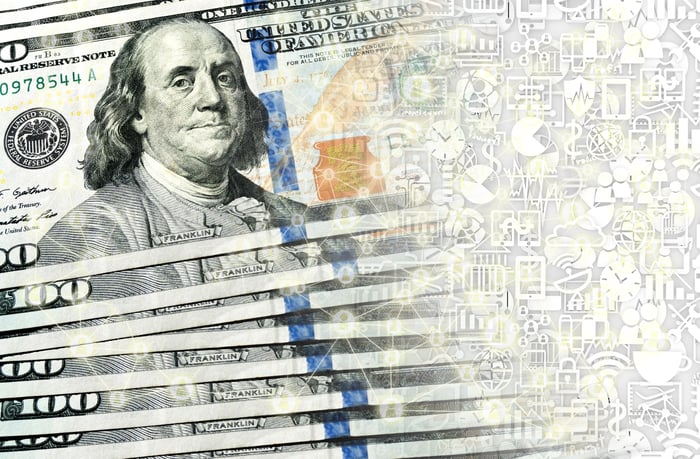If you think the stock market's historic bounce from the coronavirus crash bottom is impressive -- the S&P 500 has gained a little over 100% -- you should probably take a closer look at the cryptocurrency space. In 20 months, the aggregate value of all digital currencies has catapulted from $141 billion to $2.45 trillion. That's a more than 16-fold gain.
While there are nearly 15,000 cryptocurrencies now listed by CoinMarketCap.com, there's one that's stood head and shoulders above all others in 2021: meme coin Shiba Inu (SHIB -3.22%).

The Shiba Inu dog breed has inspired a number of big gains in the crypto space in 2021. Image source: Getty Images.
Shiba Inu's year-to-date gains are jaw-dropping, but they likely won't last
If you've heard about Shiba Inu and wondered why people can't stop talking about it in 2021, the answer lies with its jaw-dropping year-to-date gains. At midnight on Jan. 1, SHIB could be purchased for a microscopic $0.000000000073 per token. As of this past weekend, they were going for $0.00003846 per coin, equating to a year-to-date gain of 52,684,832%. This means a $1.90 investment at midnight on Jan. 1 would have made you a millionaire, as of Nov. 27.
The world's hottest cryptocurrency has benefited from a multitude of catalysts, including more crypto exchanges listing SHIB for trading, the launch of decentralized exchange ShibaSwap in July, the burning of approximately 41% of Shiba Inu's outstanding coin supply, and the fear of missing out (FOMO).
Unfortunately, few of the catalysts in Shiba Inu's sails strengthen its real-world use case or make it a payment coin that businesses are champing at the bit to employ. Aside from landing movie theater chain AMC Entertainment, just 369 merchants worldwide have given the green light to accept SHIB as payment.
Additionally, Shiba Inu lacks the differentiation necessary to stand out from an increasingly competitive space. Shiba Inu is an ERC-20 token built on the Ethereum (ETH -4.99%) blockchain. This means it's tethered to the same high transaction fees and potential lag times that plague the extremely popular network. With new crypto projects debuting daily, Shiba Inu is constantly being diluted by superior innovation.
And if you need one more reason to keep your distance in December and beyond, consider this: Virtually all five-and-six-digit payment coin percentage gains in a short time frame have been met by reversals ranging from 93% to 99%. SHIB may be up big in 2021, but it's primed to have an awful next couple of months or years, according to history.
These digital currencies have far more potential than Shiba Inu
Instead of putting your money to work in what appears to be a hype-driven coin with little substance, I'd encourage long-term-oriented investors to buy the following three cryptocurrencies in a heartbeat over SHIB.

Image source: Getty Images.
Cardano
First up is Cardano (ADA -5.49%), which I believe is a considerably more exciting blockchain project that offers real-world utility. It's worth noting that Cardano is one spot behind Shiba Inu in terms of monthly Google searches in the U.S.
What's fascinating about Cardano is how its developers have laid out very clear stepping stones that will be implemented to improve processing speeds, lower transaction costs, increase security, and massively scale the network. In total, there are five key steps, with three of the project's major upgrades already in play.
Cardano's two biggest evolutions occurred in July 2020 and September 2021. In July 2020, the Shelley upgrade went into effect, allowing network participants to run an increased number of nodes. In the wake of Shelley, the average number of transactions on Cardano's blockchain surged from around 2,000 a day to well over 100,000.
Then came Goguen in September 2021, which introduced smart contracts to Cardano's blockchain. Smart contracts help to verify, facilitate, and enforce the negotiation of a contract between two parties. Incorporating smart contracts allows Cardano to go head-to-head with Ethereum, and should encourage the development of decentralized applications (dApps) on the network.
Furthermore, Cardano is fast. Whereas Shiba Inu is limited by the Ethereum network's processing capacity of 13 transactions per second (TPS), Cardano was topping 250 TPS four years ago. The rollout of the Hydra upgrade, which has no specific timetable, will funnel transactions off-chain to staking pools, known as Hydra Nodes. This should vastly improve the scaling and speed of the network.

Arguably no blockchain-based network sends money from Point A to B faster than Nano. Image source: Getty Images.
Nano
Another cryptocurrency to confidently buy in a heartbeat over Shiba Inu is the long-forgotten Nano (NANO -7.33%), which has fallen to No. 144 on CoinMarketCap.com, in terms of market cap rank. Down 86% from its all-time high hit nearly four years ago, Nano has a unique blockchain network that should prove meaningful in the real world over the long run.
The really cool aspect of Nano's blockchain is its design. Instead of a central blockchain, Nano employs what's known as a block-lattice blockchain. With the block-lattice, every user has their own blockchain that they can add to. With users not having to compete with others for blocks on the main chain or waiting to gain consensus, Nano's network offers incredible speed and rapid scalability that won't adversely impact performance.
How fast is Nano? According to developers, it offers "a median transaction time of less than one second." Compare this to existing payment infrastructure in place today that can take up to a week to validate and settle cross-border transactions.
What's more, Nano's network executes digital peer-to-peer payment free of charge. Utilizing Open Representative Voting helps to keep the network fee-less, which is a clear step up from the existing payment infrastructure.
Investing in Nano will require patience, but it offers clear competitive advantages in the payments space.

Image source: Getty Images.
Algorand
A third cryptocurrency to buy hand over fist instead of Shiba Inu in December is Algorand (ALGO -5.55%). Although the 22nd-largest digital currency by market cap has generated a "modest" 369% gain in 2021, relative to Shiba Inu's moonshot return, it offers far more real-world use potential than SHIB ever will.
While there are a number of unique aspects that can make Algorand a success, two things really stand out. First, Algorand's secret sauce is its refined proof-of-stake consensus mechanism, known as pure-proof-of-stake (PPoS). Without getting overly complicated, PPoS chooses users at random to vote on proposals and propose blocks. With this process randomized, it ensures that a small group of hodlers can't disrupt the network.
The other key for Algorand's developers is recognizing the importance of blockchain interoperability. Right now, there are tens of thousands of blockchain projects in development worldwide. Many of these projects are unique, and will therefore struggle to work with other platforms. In other words, if Business A wants to send money, files, or data to Business B, but the two parties are using unique blockchain networks, this very likely wouldn't be possible. Algorand has a keen eye on the business world and is targeting its blockchain solutions at bridging these gaps.
Aside from being a logical candidate to foster dApp development, Algorand also wows with its speed. As of this past weekend, the network had a reported block finality of 4.39 seconds and 1,152 TPS. In other words, transactions are being completed in under five seconds, and Algorand's network is processing about 88 times faster than Ethereum. These are numbers that'll rightly garner the attention of businesses.





